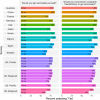Correlates of intended COVID-19 vaccine acceptance across time and countries: results from a series of cross-sectional surveys
- PMID: 34341047
- PMCID: PMC8331327
- DOI: 10.1136/bmjopen-2020-048025
Correlates of intended COVID-19 vaccine acceptance across time and countries: results from a series of cross-sectional surveys
Abstract
Objective: Describe demographical, social and psychological correlates of willingness to receive a COVID-19 vaccine.
Setting: Series of online surveys undertaken between March and October 2020.
Participants: A total of 25 separate national samples (matched to country population by age and sex) in 12 different countries were recruited through online panel providers (n=25 334).
Primary outcome measures: Reported willingness to receive a COVID-19 vaccination.
Results: Reported willingness to receive a vaccine varied widely across samples, ranging from 63% to 88%. Multivariate logistic regression analyses reveal sex (female OR=0.59, 95% CI 0.55 to 0.64), trust in medical and scientific experts (OR=1.28, 95% CI 1.22 to 1.34) and worry about the COVID-19 virus (OR=1.47, 95% CI 1.41 to 1.53) as the strongest correlates of stated vaccine acceptance considering pooled data and the most consistent correlates across countries. In a subset of UK samples, we show that these effects are robust after controlling for attitudes towards vaccination in general.
Conclusions: Our results indicate that the burden of trust largely rests on the shoulders of the scientific and medical community, with implications for how future COVID-19 vaccination information should be communicated to maximise uptake.
Keywords: COVID-19; preventive medicine; public health.
© Author(s) (or their employer(s)) 2021. Re-use permitted under CC BY-NC. No commercial re-use. See rights and permissions. Published by BMJ.
Conflict of interest statement
Competing interests: None declared.
Figures




References
-
- Porterfield C. Global coronavirus death Toll tops 2.5 million — though new fatalities have dropped. Forbes, 2021. Available: https://www.forbes.com/sites/carlieporterfield/2021/02/25/global-coronav... [Accessed 3 Mar 2021].
-
- International Monetary Fund . World economic outlook, October 2020: a long and difficult ascent. Washington, DC, 2020. Available: https://www.imf.org/en/Publications/WEO/Issues/2020/09/30/world-economic... [Accessed 29 Nov 2020].
-
- Schoch-Spana M, Brunson EK, Long R, et al. The public's role in COVID-19 vaccination: Human-centered recommendations to enhance pandemic vaccine awareness, access, and acceptance in the United States. Vaccine 2020. 10.1016/j.vaccine.2020.10.059. [Epub ahead of print: 29 Oct 2020]. - DOI - PMC - PubMed
Publication types
MeSH terms
Substances
LinkOut - more resources
Full Text Sources
Medical
